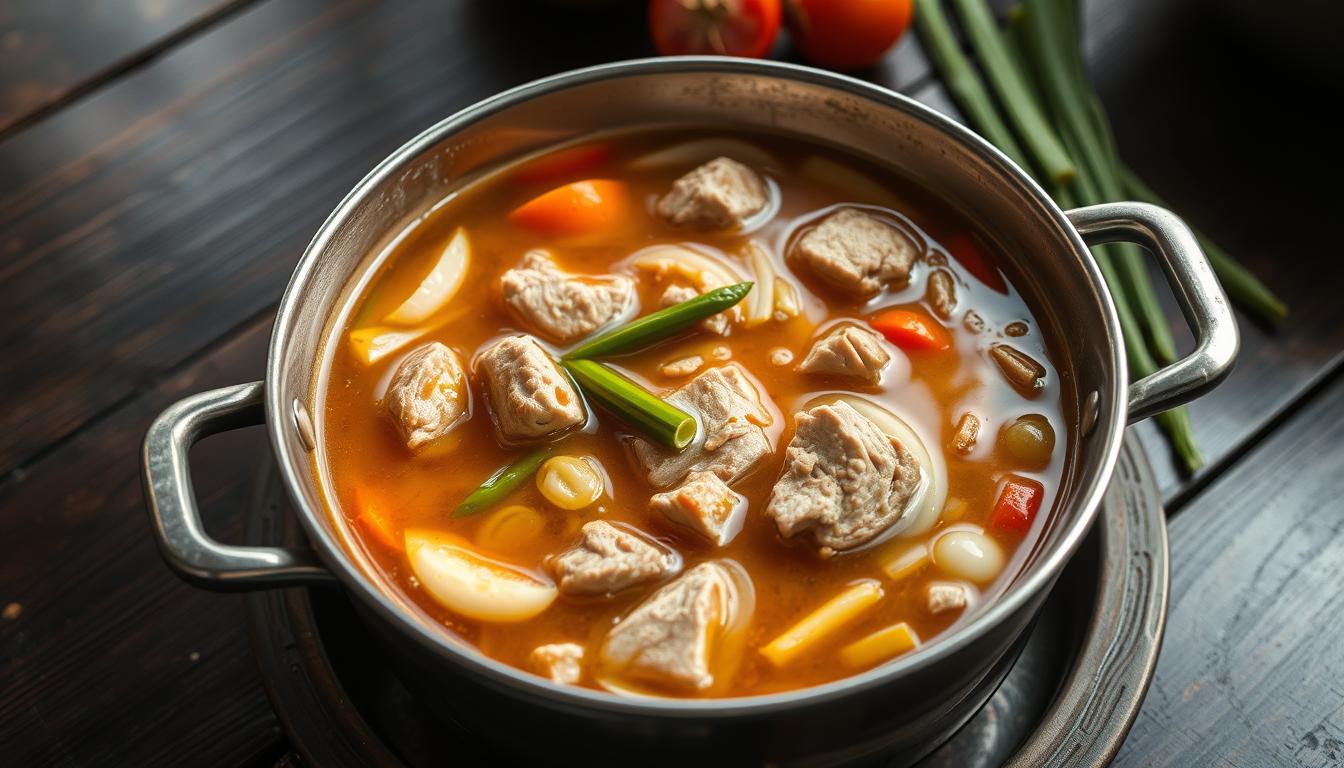Imagine the first spoonful of steaming sinigang, its tangy broth cutting through tender pork belly, vegetables crisp yet tender, and the unmistakable aroma of tamarind wrapping around you. This dish isn’t just a meal—it’s a connection to generations of Filipino kitchens where every simmered ingredient carries a story. Traditional sinigang is more than a recipe; it’s a taste of home, no matter where you are.
Think about the first time you tasted this sour soup. Was it at your lola’s table, or maybe in a bustling Manila market? The sinigang recipe you’ll explore here honors that legacy, blending time-honored techniques with the flexibility to adapt it to your pantry. Every bite of this Filipino staple is a balance of bold flavors that comfort and excite.
Key Takeaways
- Traditional sinigang’s foundation is tamarind, creating its signature sour profile.
- Pork belly and fresh vegetables like okra and radish are core to the classic version.
- Mastering the sinigang recipe requires balancing acidity, saltiness, and sweetness.
- This dish is a cultural anchor, reflecting shared meals and family traditions.
- Adapting the recipe while respecting its roots ensures it stays meaningful for modern kitchens.
Table of Contents
Understanding Sinigang: A Filipino Culinary Tradition

Sinigang’s sharp, tangy flavor traces back centuries, making it a cornerstone of filipino sour soup traditions. This dish isn’t just a meal—it’s a story of cultural exchange and resilience.
Origins and History
The tamarind fruit, central to sinigang’s signature acidity, was traded across Southeast Asia long before Spanish colonization. Filipino communities blended indigenous ingredients like fish, pork, and local vegetables to create a dish that adapted to regional tastes. Over time, spices and techniques from Malay, Spanish, and Chinese traders shaped its evolution. Today, every spoonful of filipino sour soup reflects this layered heritage.
Cultural Significance in Filipino Cuisine
For many, preparing how to make sinigang is a ritual passed through generations. Families gather to select proteins like mackerel or radish to simmer in the broth, turning kitchens into spaces of shared memories. The dish’s sourness isn’t just a flavor—it symbolizes balance, much like Filipino values of unity and harmony. Whether at fiestas or quiet weeknights, sinigang remains a link to identity, proving that food is more than sustenance; it’s a language of belonging.
Ingredients That Make an Authentic Sinigang

Every ingredient in pork sinigang contributes to its signature tangy and savory flavor. Tamarind is the star, creating the dish’s distinct sourness. Pork provides richness, while vegetables add texture and nutrients. Here’s how each part works together:
| Ingredient | Role | Why It Matters |
|---|---|---|
| Tamarind | Base sour flavor | Defines the dish’s iconic taste |
| Pork | Protein and depth | Essential in traditional pork sinigang |
| Vegetables | Texture and nutrients | Radish, eggplant, and taro balance the broth |
Onions and tomatoes build the foundation, releasing natural sweetness when sautéed. Leafy greens like kangkong (water spinach) add freshness in the final minutes. When selecting pork, opt for cuts like pork ribs or belly for maximum flavor. Vegetables should be added in order of cooking time—root veggies first, tender greens last.
- Tamarind: Use blocks or paste for authenticity
- Pork: Marinate briefly in soy sauce before cooking
- Vegetables: Choose seasonal varieties for best texture
Properly balancing these elements ensures your pork sinigang has the right acidity, richness, and vibrancy. Every bite should reflect the harmony of Filipino culinary tradition.
How to Make Sinigang: Step-by-Step Instructions
Master the tamarind soup foundation of this dish with this easy sinigang recipe. Follow these simple steps to create a savory, tangy broth that highlights Filipino flavors.
Preparing the Tamarind Base
Start by brewing the tamarind base, the heart of your tamarind soup. Crush dried tamarind pulp or use prepared paste, simmering it in water until it releases its sourness. Strain the liquid to remove solids, then season with fish sauce or salt. This broth forms the base for your dish.
Cooking Pork Sinigang to Perfection
Begin with pork cubes. Sauté them in a pot until browned, then add the tamarind broth. Let the meat simmer until tender—about 30 minutes. A fork should easily pierce the pork when done.
Simmering the Vegetables and Seasonings
Add vegetables like radish, okra, and eggplant once the pork is cooked. Simmer for 5–7 minutes to retain crispness. Lastly, include leafy greens like kangkong (water spinach) and bok choy for the final 2 minutes. Taste and adjust sourness with more tamarind or salt.
Follow these steps to balance flavors and textures, ensuring every ingredient shines in your homemade easy sinigang recipe. Serve hot with steamed rice for a comforting, authentic meal.
Exploring Variations: Traditional Sinigang vs. Easy Sinigang Recipe
Traditional sinigang na baboy recipe uses fresh tamarind pulp for depth, while modern versions simplify with bottled souring agents. Both methods deliver tangy, savory flavors but differ in prep time and ingredients.
| Traditional Sinigang | Easy Sinigang Recipe |
|---|---|
| Fresh tamarind soaked and strained | Prepared tamarind sauce or cubes |
| Pork belly simmered slowly | Pork cuts cooked quickly |
| 2+ hour preparation | 30-minute prep-to-table |
| Regional spice additions like siling labuyo | Standard seasoning blends |
Experiment with proteins like shrimp or chicken to adapt the sinigang na baboy recipe to your pantry. Try these modern tweaks:
- Use frozen pork for convenience
- Add bok choy or okra for texture
- Substitute calamansi juice for final tartness
Cooks in Manila might prefer fish sauce additions, while overseas kitchens often rely on supermarket ingredients. Balance authenticity with practicality—your taste preferences shape the final dish.
Tips for Perfecting Your Sinigang
Mastery of sinigang lies in its balance of tangy and savory notes. Follow these steps to refine your recipe and avoid common pitfalls.
Balancing the Sour Flavor
Start by tasting the tamarind base before adding ingredients. Too sharp? Dilute with water. Too mild? Simmer longer to concentrate the sourness.
| Issue | Solution |
|---|---|
| Overly sour broth | Add sugar or fish sauce to neutralize acidity |
| Weak flavor | Use dried tamarind pulp for deeper taste |
Adjusting the Seasoning to Your Taste
- Season with patis (fish sauce) last to preserve freshness.
- Pair with calamansi juice for brightness.
- Add salt gradually—overseasoning masks the pork sinigang’s natural flavors.
Experiment with small batches before scaling up. Adjust vegetables like radish or okra for texture, but never overcrowd the pot—this ensures even cooking.
Health Benefits of This Filipino Sour Soup
Sinigang’s tangy flavor isn’t the only reason to love this dish. This Filipino classic packs a nutritional punch that supports your overall well-being. Every spoonful delivers vitamins, minerals, and antioxidants from fresh ingredients like tomatoes, okra, and leafy greens.
Low in calories, sinigang makes it easy to maintain a balanced diet without sacrificing taste. The tamarind base adds natural acidity, which can improve digestion by stimulating stomach enzymes. Pair that with lean proteins like fish or pork, and you get a meal that’s both satisfying and light.
- Rich in Vitamin C: Tamarind and vegetables boost immunity and skin health.
- Antioxidant power: Ingredients like radish and taro reduce inflammation and protect cells from damage.
- Heart-healthy: Many vegetables in sinigang contain fiber and potassium, which support cardiovascular health.
Choosing sinigang means fueling your body with nutrients while enjoying a cultural staple. Its balanced mix of protein, veggies, and sour broth makes it a smart choice for anyone seeking comfort food that nourishes you inside and out.
Sinigang Recipe Adaptations for Your Kitchen
Ready to put your own spin on this Filipino classic? Sinigang’s flexibility lets you tweak it to match your kitchen’s ingredients and dietary needs. Whether you’re avoiding pork or craving new flavors, here’s how to innovate without losing the dish’s essence.
Using Pork and Alternative Proteins
While pork is traditional, swap it out for:
- Shrimp (boil briefly for 3-5 minutes to keep tender)
- Chicken thighs (marinate in garlic for extra depth)
- Tofu (use firm tofu for a meatless option)
- Beef (go for tender cuts like sirloin)
Pair proteins with your favorite veggies like okra, eggplant, or bitter melon.
Modern Twists on a Classic Dish
Experiment with bold flavors:
- Add coconut milk for a creamy base.
- Try kaffir lime leaves instead of bay leaves.
- Top with fresh herbs like Thai basil or cilantro.
“Sinigang isn’t set in stone—make it your own!”
Adjust sourness by mixing tamarind pulp with store-bought sinigang powder. Serve with steamed rice and a squeeze of calamansi. These tweaks keep the dish fresh while honoring its roots.
Cooking Essentials: Tools and Techniques for the Ultimate Sinigang Experience
Perfecting sinigang hinges on the right equipment and methods. Every tool and step plays a role in achieving that signature clarity and depth. Here’s how to equip yourself:
- Sturdy Pot: A deep, wide pot like All-Clad’s stainless steel ensures even heat distribution and prevents overflow during simmering.
- Slotted Spoon: Use it to skim surface scum, keeping broth clean and clear.
- Measuring Spoons: Precision matters when balancing sourness—use them for tamarind powder or vinegar.
- Sharp Knife: Chopping veggies evenly ensures even cooking.
- Blanch Pork First: Boil meat briefly to remove grease, then rinse before adding to broth.
- Control the Simmer: Keep heat low to avoid boiling that clouds the broth and toughens meat.
- Stage Vegetables: Add hard vegetables (like radish) first, greens like spinach last to retain color and crunch.
- Season Gradually: Taste and adjust salt and sourness 10 minutes before serving for best balance.
Quality tools and mindful steps ensure your sinigang shines. From the right pot to timing additions, every detail matters in this Filipino classic.
Conclusion
Making Sinigang is more than cooking—it’s a gateway to Filipino culture. This dish blends tradition with your personal touch, using ingredients like tamarind and pork to create a sour, savory broth. Every step from preparing the tamarind base to simmering vegetables reflects centuries of culinary heritage.
Health meets flavor in every spoonful. Tamarind offers natural tartness, while lean proteins like pork or shrimp keep the dish nutritious. Whether you follow a classic recipe or swap in tofu for a vegetarian version, Sinigang adapts to your kitchen’s needs without losing its essence.
Explore modern twists while respecting tradition. Use fresh or store-bought souring agents, and adjust spices to suit your palate. This dish invites experimentation, proving that even centuries-old recipes can evolve with your preferences.
Bring Sinigang’s vibrant flavors to your table. Share it with family, and let it spark conversations about its roots. Every bowl you cook honors Filipino culinary artistry while creating new memories. Start your journey into this iconic soup, and savor how it connects past and present with every bite.

